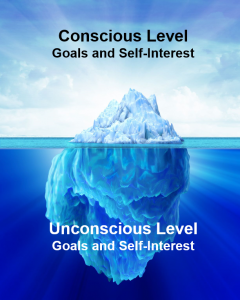Winning sales reps have learned that you must connect and your message must resonate with the prospect before you can share your insight and convince the prospect to take action. That’s where storytelling comes into the picture. The psychological goal of influence is to connect your goals to your prospect’s self-interest.
The goals and self-interest of the prospect are like an iceberg – part is visible above the surface (in the conscious mind) and part is invisible below the surface (in the unconscious mind). Stories are powerful because they reach both areas. They have a circular model and the listener can co-create with the teller and envision their story so the power of influence grows as it is passed between the storyteller and the listener. Stories have the power to leverage your sales efforts because they employ a pull strategy and pull attracts pull. Therefore it moves toward a collaboration which is an end point vision in insight selling. Stories also have the power to redefine situations which allows you to change or redefine the mindset of your prospect.
 A story uses the energy within the prospect. It reaches their conscious desires and those deep within the unconscious to light the flow of inspiration. Developing a good story that connects with your prospect in this way takes time and forethought. However, your effort will be rewarded. Too many people jump in too early and then they do not have the influence that a good story will provide.
A story uses the energy within the prospect. It reaches their conscious desires and those deep within the unconscious to light the flow of inspiration. Developing a good story that connects with your prospect in this way takes time and forethought. However, your effort will be rewarded. Too many people jump in too early and then they do not have the influence that a good story will provide.
 An impactful story is not like the fun stories that you tell at a bar or a cocktail party. To succeed in connecting and influencing the listener, it must tap into one of the core human needs such as identity/purpose, peace of mind/safety, caring, belonging and love, esteem needs, and self-actualization. As listed, one of the most basic needs is being acknowledged and belonging. Our high tech world of electronic connection often leaves people feeling unconnected and starved for that connected/belonging feeling. That is why storytelling has been appearing more often and is gaining momentum in business interactions.
An impactful story is not like the fun stories that you tell at a bar or a cocktail party. To succeed in connecting and influencing the listener, it must tap into one of the core human needs such as identity/purpose, peace of mind/safety, caring, belonging and love, esteem needs, and self-actualization. As listed, one of the most basic needs is being acknowledged and belonging. Our high tech world of electronic connection often leaves people feeling unconnected and starved for that connected/belonging feeling. That is why storytelling has been appearing more often and is gaining momentum in business interactions.
 I recently attended a storytelling workshop with Bo Eason, Tony Award winning actor and playwright. In that workshop, I learned that stories provide the authenticity and the relationship to things that are truly important to the listener. If you can create a story that hooks into the basic needs you can have more powerful momentum than you have previously experienced. It is crucial to include emotion to reach the listener at their core. Your prospects may be in different countries, be of different races, cultures, and different genders, but stories can reach the lower part of the iceberg, the unconscious level where we are all basic human beings.
I recently attended a storytelling workshop with Bo Eason, Tony Award winning actor and playwright. In that workshop, I learned that stories provide the authenticity and the relationship to things that are truly important to the listener. If you can create a story that hooks into the basic needs you can have more powerful momentum than you have previously experienced. It is crucial to include emotion to reach the listener at their core. Your prospects may be in different countries, be of different races, cultures, and different genders, but stories can reach the lower part of the iceberg, the unconscious level where we are all basic human beings.
 Robert Cialdini, influence expert, says that one of the strongest influences is similarity. When you connect with your story, your prospect has seen that your values and characteristics are similar. This creates trust and you can persuade those who feel connected and trust you. This is why two of the six basic story types are extremely useful at the beginning of the sales process. The “Who I Am” story and the “Values” story build trust and lay the foundation for the other types of stories as well as lead to the next step in the process.
Robert Cialdini, influence expert, says that one of the strongest influences is similarity. When you connect with your story, your prospect has seen that your values and characteristics are similar. This creates trust and you can persuade those who feel connected and trust you. This is why two of the six basic story types are extremely useful at the beginning of the sales process. The “Who I Am” story and the “Values” story build trust and lay the foundation for the other types of stories as well as lead to the next step in the process.
It is a definite mistake to jump in with an insight a strategy before making that crucial trust building connection. Since the days of the cave man, we have been designed to be cautious. The amygdala portion of the brain says take care as this could put you in danger. You must demonstrate you are not a danger but rather you have honorable intentions before proceeding to provide an insight. Most “No’s” are a result of no trust or no value.
A story can help you reach a common ground. You also want to acknowledge in your story development that you didn’t reach your conclusions and insights overnight.
As you create your story, take your listener step by step to reach the same end point vision. In some situations, it’s necessary to make multiple contacts and tell multiple stories before moving to the next step. You need to build the level of trust required to change the listener’s mindset or go to the next step in the process.
Facts in PowerPoint presentations or conversations, may quickly be forgotten. However, the gist of your story and how it made the listener feel will long be remembered.
 I found it counter intuitive but true when Bo Eason taught us that the more personal and specific the story, the more universal its impact. He also explained to us that when we begin to listen to a story, we relax, get more comfortable and can allow you to take the prospect to an awareness state that is more receptive to your insight and less logical and analytical. Now that you have connected with the buyer, you are ready to further demonstrate understanding of the customer needs and share you insights.
I found it counter intuitive but true when Bo Eason taught us that the more personal and specific the story, the more universal its impact. He also explained to us that when we begin to listen to a story, we relax, get more comfortable and can allow you to take the prospect to an awareness state that is more receptive to your insight and less logical and analytical. Now that you have connected with the buyer, you are ready to further demonstrate understanding of the customer needs and share you insights.
Let stories engage your customers and help you win the business.
About the Authors: Phyllis Mikolaitis and John Switzer are sales coaches and developers each with over 30 years’ global experience. They are dedicated to taking you beyond the typical “how to” courses to the heart of persuasion techniques incorporating insights and stories to win the sale. Read more of our posts on this site. www.salestrainingsolutions.com.




